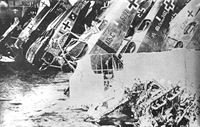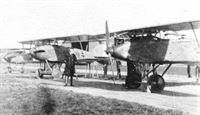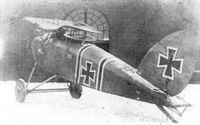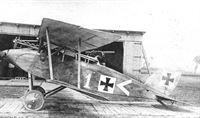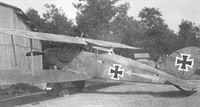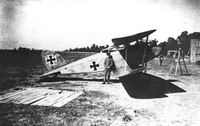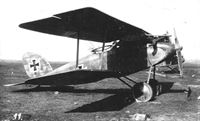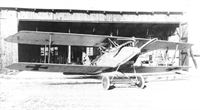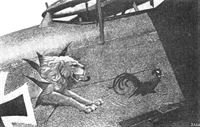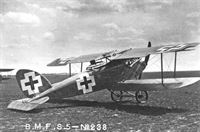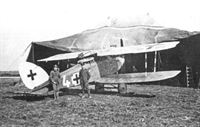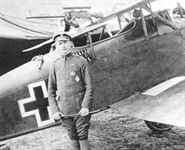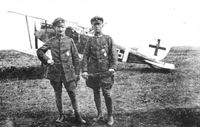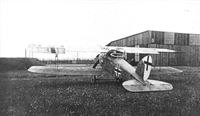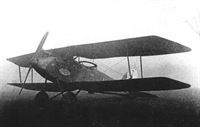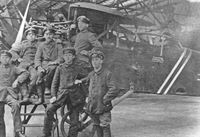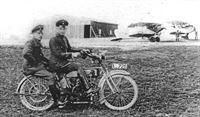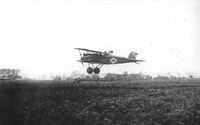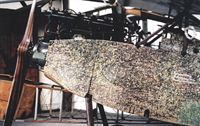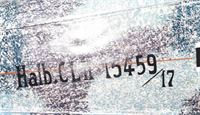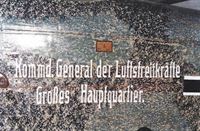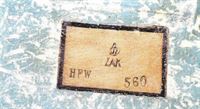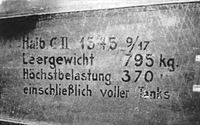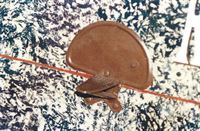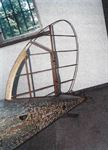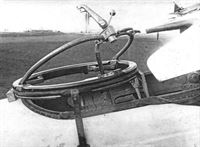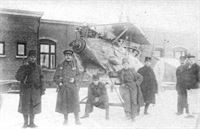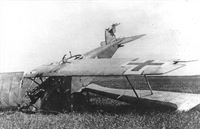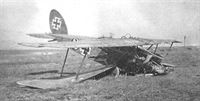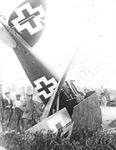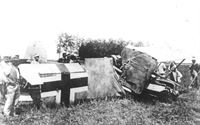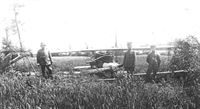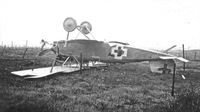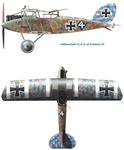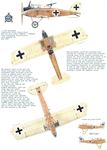Книги
Centennial Perspective
J.Herris
Halberstadt Aircraft of WWI. Volume 1: A-types to C.III
358
J.Herris - Halberstadt Aircraft of WWI. Volume 1: A-types to C.III /Centennial Perspective/ (44)
Halberstadt Boxkite
The Halberstadt-built boxkite was licensed from the Bristol Company of Britain. It was a primitive biplane of pusher configuration with twin rudders and biplane tailplane. It was powered by a 50 hp Gnome rotary. A few examples were built in 1912 and 1913; Halberstadt work numbers 1 and 6 are known.
The Halberstadt-built boxkite was licensed from the Bristol Company of Britain. It was a primitive biplane of pusher configuration with twin rudders and biplane tailplane. It was powered by a 50 hp Gnome rotary. A few examples were built in 1912 and 1913; Halberstadt work numbers 1 and 6 are known.
Halberstadt Bristol Coanda
The Halberstadt Coanda was a license-built version of the Bristol Coanda trainer. It was a two-seat monoplane powered by an 80 hp Gnome rotary. Some modifications, such as a modified tail, side by side seating, and an extended fuselage were made. Halberstadt built a few examples,- work numbers 2 and 27 are known. Two examples bought in Britain had military serials A.21/12 and A.27/12.
The Halberstadt Coanda was a license-built version of the Bristol Coanda trainer. It was a two-seat monoplane powered by an 80 hp Gnome rotary. Some modifications, such as a modified tail, side by side seating, and an extended fuselage were made. Halberstadt built a few examples,- work numbers 2 and 27 are known. Two examples bought in Britain had military serials A.21/12 and A.27/12.
The Halberstadt-Bristol Coanda was a pre-war trainer design used in small numbers. It was powered by an 80 hp Gnome rotary built under license. (Bruno Schmaling)
Intact Halberstadt-Bristol Coanda trainer with trainee and ground crew. Their heavy clothing indicates a cold day for flying but there is no snow. (Bruno Schmaling)
Modified Halberstadt Bristol Coanda with enclosed cowling and 4-wheel undercarriage gives this primitive aircraft a more modern appearance. (Peter M. Grosz collection/STDB)
BFW production Halberstadt CL.IIa(Bay) with Fliegerersatz Abteilung 8 at Graudenz school badge and other German aircraft collected for destruction postwar. (Peter M. Grosz collection/STDB)
Halberstadt CL.II and Albatros fighters of Seefrontstaffel II at Neumuenster. The Halberstadt was painted in Jagdstaffel markings with yellow nose and rudder.
Halberstadt CL.II and Albatros fighters of Seefrontstaffel II at Neumuenster. The Halberstadt was painted in Jagdstaffel markings with yellow nose and rudder.
Halberstadt A.II
The Halberstadt A.II was a single engine, two-seat, shoulder-wing monoplane powered by a 100 hp Oberursel U.I nine-cylinder rotary engine. The fuselage was rectangular in cross section and was made of fabric-covered steel tube. The monoplane wings were of rectangular planform with ailerons, not wing warping. The rudder was a single structure above the fuselage and the undercarriage had two wheels. The fuselage was rectangular and made of wood.
Basically, the A.II was a replica of the Fokker M 8 with minor modifications such as omitting the side windows. A few examples were built in the Autumn of 1914 and saw front-line service as shown by the A-type Frontbestand table.
The Halberstadt A.II was a single engine, two-seat, shoulder-wing monoplane powered by a 100 hp Oberursel U.I nine-cylinder rotary engine. The fuselage was rectangular in cross section and was made of fabric-covered steel tube. The monoplane wings were of rectangular planform with ailerons, not wing warping. The rudder was a single structure above the fuselage and the undercarriage had two wheels. The fuselage was rectangular and made of wood.
Basically, the A.II was a replica of the Fokker M 8 with minor modifications such as omitting the side windows. A few examples were built in the Autumn of 1914 and saw front-line service as shown by the A-type Frontbestand table.
Halberstadt-Fokker
The Halberstadt-Fokker appears to be basically a Fokker M.10 two-seater fuselage, engine, and tailplane with different wing cellule and cabane strut arrangement built by Halberstadt. The wing cellule is very similar (identical?) to that of the Halberstadt B.I. This may have been an experimental B-type built by Halberstadt in 1915 that did not go into production.
The engine appears to be a 80 hp Oberursel U.O seven-cylinder rotary. It is unknown how many were built or used at the front.
The Halberstadt-Fokker appears to be basically a Fokker M.10 two-seater fuselage, engine, and tailplane with different wing cellule and cabane strut arrangement built by Halberstadt. The wing cellule is very similar (identical?) to that of the Halberstadt B.I. This may have been an experimental B-type built by Halberstadt in 1915 that did not go into production.
The engine appears to be a 80 hp Oberursel U.O seven-cylinder rotary. It is unknown how many were built or used at the front.
Halberstadt-Bristol Taube I
Also known as the Halberstadt Military Taube, this monoplane was powered by a 100 hp Mercedes D.I six-cylinder engine cooled by side radiators. The wing was braced with a bridge and a u-shaped tension tower. The undercarriage was two main wheels supplemented by two auxiliary wheels and extensive bracing. The airframe was made of wood.
A small number of these aircraft were built in 1913 at the height of the Taube craze in Germany and work numbers 40, 43, and 44 are known.
Halberstadt-Bristol Taube II Rover
The Halberstadt-Bristol Taube II Rover was a monoplane powered by a 50 hp Argus four-cylinder engine cooled by side radiators. The wings were braced with a truss and the airframe was made of wood. The robust oval fuselage was built based on the Rover patent. Roll control was by wing-warping. The rudder was a double structure above and below the fuselage. The undercarriage had two wheels.
A few examples were built in 1913/1914.
Halberstadt-Bristol Taube III
The Halberstadt-Bristol Taube III was a monoplane powered by a 100 hp Mercedes six-cylinder engine cooled by side radiators. The wings were braced with a truss and the airframe was made of wood with oval fuselage built according to the Rover patent. Roll control was by hinged ailerons with actuating cables that strongly resembled earlier Taubes with wing warping. The rudder was a single structure above the fuselage. The undercarriage had two wheels.
Overall it was a more modern design that the Halberstadt Taube II; a few examples were built in 1914 with work number 53 known.
Halberstadt-Bristol Taube IV
The Halberstadt-Bristol Taube IV was a monoplane powered by a 75 hp Mercedes six-cylinder engine cooled by side radiators. The wings were braced with a truss and the airframe was made of wood. Roll control was by wing warping. The rudder was a double structure above and below the fuselage. The undercarriage had two wheels. In many ways it was a more primitive design than the earlier Halberstadt Taube III.
A few examples were built in 1914 with work numbers 47, 55, and 84 known. In addition, military serial A. 7/14 is known.
Also known as the Halberstadt Military Taube, this monoplane was powered by a 100 hp Mercedes D.I six-cylinder engine cooled by side radiators. The wing was braced with a bridge and a u-shaped tension tower. The undercarriage was two main wheels supplemented by two auxiliary wheels and extensive bracing. The airframe was made of wood.
A small number of these aircraft were built in 1913 at the height of the Taube craze in Germany and work numbers 40, 43, and 44 are known.
Halberstadt-Bristol Taube II Rover
The Halberstadt-Bristol Taube II Rover was a monoplane powered by a 50 hp Argus four-cylinder engine cooled by side radiators. The wings were braced with a truss and the airframe was made of wood. The robust oval fuselage was built based on the Rover patent. Roll control was by wing-warping. The rudder was a double structure above and below the fuselage. The undercarriage had two wheels.
A few examples were built in 1913/1914.
Halberstadt-Bristol Taube III
The Halberstadt-Bristol Taube III was a monoplane powered by a 100 hp Mercedes six-cylinder engine cooled by side radiators. The wings were braced with a truss and the airframe was made of wood with oval fuselage built according to the Rover patent. Roll control was by hinged ailerons with actuating cables that strongly resembled earlier Taubes with wing warping. The rudder was a single structure above the fuselage. The undercarriage had two wheels.
Overall it was a more modern design that the Halberstadt Taube II; a few examples were built in 1914 with work number 53 known.
Halberstadt-Bristol Taube IV
The Halberstadt-Bristol Taube IV was a monoplane powered by a 75 hp Mercedes six-cylinder engine cooled by side radiators. The wings were braced with a truss and the airframe was made of wood. Roll control was by wing warping. The rudder was a double structure above and below the fuselage. The undercarriage had two wheels. In many ways it was a more primitive design than the earlier Halberstadt Taube III.
A few examples were built in 1914 with work numbers 47, 55, and 84 known. In addition, military serial A. 7/14 is known.
Halberstadt Bristol Taube I with Its four-wheel undercarriage and side radiators was distinctive. (Peter M.Grosz collection/STDB)
Halberstadt Bristol Taube I with Its four-wheel undercarriage and side radiators. (Peter M. Grosz collection/STDB)
Halberstadt Bristol Taube I in flight. Its four-wheel undercarriage is distinctive. (Peter M. Grosz collection/STDB)
Halberstadt-Bristol Taube II Rover of 1913 powered by a 50 hp Argus four-cylinder engine. (Peter M. Grosz collection/ STDB)
Halberstadt-Bristol Taube II Rover. The photo was taken during an aviation competition. (Peter M. Grosz collection/STDB)
Five men sitting on the fuselage of the Halberstadt-Bristol Taube II Rover demonstrate the strength of the fuselage.
Halberstadt-Bristol Taube III next to the assembly hall. Halberstadt work number 53 is painted on the fin. (Peter M. Grosz collection/STDB)
Halberstadt-Bristol Taube III was a more developed design than is predecessor. It featured primitive ailerons; simplified tail, and a sturdy fuselage based on the Rover patent. (Peter M. Grosz collection/STDB)
The Halberstadt-Bristol Taube IV was a more primitive design than the Halberstadt-Bristol Taube III. It lacked ailerons, the fuselage was not as streamlined or sturdy, and the tail was more primitive. Halberstadt work number 47 is painted on the fin. (Peter M. Grosz collection/STDB)
Halberstadt-Bristol Taube IV with ground crew and pilot. Halberstadt work number 55 is painted on the fin. (Peter M. Grosz collection/STDB)
Halberstadt-Bristol Taube II Rover (Taube IV ???) ready for flight. (Peter M. Grosz collection/STDB)
Halberstadt-Bristol Taube II Rover (Taube IV ???) ready for flight. (Peter M. Grosz collection/STDB)
Lineup of Halberstadt-Bristol Taube IV trainers at the flight school. (Peter M. Grosz collection/STDB)
Halberstadt-Bristol Taube II Rover (Taube IV ???) dismantled for transportation by railroad. (Peter M. Grosz collection/STDB)
Halberstadt A.I
The Halberstadt A.I was a single engine, two-seat Taube powered by a 100 hp Mercedes D.I six-cylinder engine cooled by side radiators. The monoplane wings had ailerons, not wing warping. The rudder was a single structure above the fuselage, the tailplane had elevators and fixed stabilizers, and the undercarriage had two wheels. The fuselage was rectangular and made of wood.
A few examples were built in 1914; one known military serial number is A. 164/14.
The Halberstadt A.I was a single engine, two-seat Taube powered by a 100 hp Mercedes D.I six-cylinder engine cooled by side radiators. The monoplane wings had ailerons, not wing warping. The rudder was a single structure above the fuselage, the tailplane had elevators and fixed stabilizers, and the undercarriage had two wheels. The fuselage was rectangular and made of wood.
A few examples were built in 1914; one known military serial number is A. 164/14.
Halberstadt A.I was a Taube with ailerons. Note the large insignia. (Peter M. Grosz collection/STDB)
Halberstadt B-Type
The Halberstadt B-type used a rectangular, tubular steel fuselage derived from the Fokker M 8 fuselage. To that a biplane wing cellule with 3 1/2 bay bracing was added, although no cabane struts were fitted. The engine was an 80 hp Uberursel U.O seven-cylinder rotary.
The wings were of rectangular planform but the ailerons extended back beyond the wing's trailing edge. The main undercarriage had two pairs of dual wheels attached to U-shaped struts. No fixed fin was fitted; however, the rudder was large. The tailplane had fixed horizontal stabilizers and a movable elevator.
The aircraft had features that previewed later B-types and D-types.
At least two examples were built at the end of 1914; work numbers 117 and 118 are known [Hindenburg I and II).
The Halberstadt B-type used a rectangular, tubular steel fuselage derived from the Fokker M 8 fuselage. To that a biplane wing cellule with 3 1/2 bay bracing was added, although no cabane struts were fitted. The engine was an 80 hp Uberursel U.O seven-cylinder rotary.
The wings were of rectangular planform but the ailerons extended back beyond the wing's trailing edge. The main undercarriage had two pairs of dual wheels attached to U-shaped struts. No fixed fin was fitted; however, the rudder was large. The tailplane had fixed horizontal stabilizers and a movable elevator.
The aircraft had features that previewed later B-types and D-types.
At least two examples were built at the end of 1914; work numbers 117 and 118 are known [Hindenburg I and II).
This is the Halberstadt B-type work number 117, the original Hindenburg (or Hindenburg I after the second aircraft was built). The work number is barely visible on the rudder.
This is the Halberstadt B-type work number 118, the Hindenburg II. The movable rudder has been reduced in size and is a different shape from the original Hindenburg. The work number is barely visible on the rudder.
Halberstadt-Bristol Experimental Biplane
The Halberstadt-Bristol Experimental Biplane was a single engine, two-seat biplane powered by a 100 hp Oberursel U.I 9-cylinder rotary engine. The biplane wings had three bays of interplane struts. The rudder was a single structure above the fuselage and the undercarriage had two wheels. The circular fuselage was made of wood and built in the Lameller way after the Rover patent.
One example of this aircraft was built at the beginning of 1914.
The Halberstadt-Bristol Experimental Biplane was a single engine, two-seat biplane powered by a 100 hp Oberursel U.I 9-cylinder rotary engine. The biplane wings had three bays of interplane struts. The rudder was a single structure above the fuselage and the undercarriage had two wheels. The circular fuselage was made of wood and built in the Lameller way after the Rover patent.
One example of this aircraft was built at the beginning of 1914.
Halberstadt B.I
The Halberstadt B.I was a single-engine, two-seat trainer and reconnaissance aircraft powered by an 80 hp Oberursel U.O seven-cylinder rotary engine. The fuselage was again based on the rectangular, fabric-covered steel tube fuselage from the Fokker M 8 to which was added a biplane wing cellule.
The wings were rectangular planform with two bays of bracing and cabane struts. The upper wing had slightly greater span that the lower. A simple undercarriage like most WWI aircraft used was fitted; many aircraft used a claw brake. The tailplane was fully movable with no fixed surfaces.
Halberstadt built about 50 B.l aircraft in 1915. Some had a flexible Parabellum LMG 14 for the observer, some had a fixed Spandau LMG 08/15 for the pilot, and others may have had both guns.
Work numbers 97 and 111 are known, and military serials 355-359/14, 652-654/15, and 657/15 are also known. A small number were at the front from late 1914 through early 1915.
Halberstadt B.II
Like the B.I, the Halberstadt B.II was also a trainer and reconnaissance plane. However, instead of a rotary it was powered by a 100 hp Mercedes D.I six-cylinder engine with side radiators. In fact, it was essentially a B.I adopted for a Mercedes inline, water-cooled engine.
The prototype had a shorter span, almost identical to the B.I, but due to the heavier engine the span of production aircraft had to be increased to 12.0 m. Wing area was 32.0 m2, empty weight ws 641 kg, and useful load was 220 kg. Climb to 1,000 m took 7 minutes, 2,000 m was 15 minutes, and to 3,000 m took 29 and a half minutes.
A number of aircraft were produced and serial numbers 150/15, 157/15, 648/15, 1243/15, 1245/15, 1254/15, 1285/15, 1286/15, and 1288/15 are known. A small number were at the front from late 1914 through early 1915.
Halberstadt B.III
Like the earlier B.I and B.II, the Halberstadt B.III was also a trainer and reconnaissance biplane; however, it was powered by a 120 hp Mercedes D.II six-cylinder engine with side radiators. In fact, it was essentially a B.II adopted for a more powerful engine. Although it was still a two-bay aircraft, with a span of 12 meters it had a longer wing span than the B.II.
A few Halberstadt B.III aircraft were built in 1915 and military serials 1455-1462/15 are known. A small number were at the front from late 1914 through early 1915.
The Halberstadt B.I was a single-engine, two-seat trainer and reconnaissance aircraft powered by an 80 hp Oberursel U.O seven-cylinder rotary engine. The fuselage was again based on the rectangular, fabric-covered steel tube fuselage from the Fokker M 8 to which was added a biplane wing cellule.
The wings were rectangular planform with two bays of bracing and cabane struts. The upper wing had slightly greater span that the lower. A simple undercarriage like most WWI aircraft used was fitted; many aircraft used a claw brake. The tailplane was fully movable with no fixed surfaces.
Halberstadt built about 50 B.l aircraft in 1915. Some had a flexible Parabellum LMG 14 for the observer, some had a fixed Spandau LMG 08/15 for the pilot, and others may have had both guns.
Work numbers 97 and 111 are known, and military serials 355-359/14, 652-654/15, and 657/15 are also known. A small number were at the front from late 1914 through early 1915.
Halberstadt B.II
Like the B.I, the Halberstadt B.II was also a trainer and reconnaissance plane. However, instead of a rotary it was powered by a 100 hp Mercedes D.I six-cylinder engine with side radiators. In fact, it was essentially a B.I adopted for a Mercedes inline, water-cooled engine.
The prototype had a shorter span, almost identical to the B.I, but due to the heavier engine the span of production aircraft had to be increased to 12.0 m. Wing area was 32.0 m2, empty weight ws 641 kg, and useful load was 220 kg. Climb to 1,000 m took 7 minutes, 2,000 m was 15 minutes, and to 3,000 m took 29 and a half minutes.
A number of aircraft were produced and serial numbers 150/15, 157/15, 648/15, 1243/15, 1245/15, 1254/15, 1285/15, 1286/15, and 1288/15 are known. A small number were at the front from late 1914 through early 1915.
Halberstadt B.III
Like the earlier B.I and B.II, the Halberstadt B.III was also a trainer and reconnaissance biplane; however, it was powered by a 120 hp Mercedes D.II six-cylinder engine with side radiators. In fact, it was essentially a B.II adopted for a more powerful engine. Although it was still a two-bay aircraft, with a span of 12 meters it had a longer wing span than the B.II.
A few Halberstadt B.III aircraft were built in 1915 and military serials 1455-1462/15 are known. A small number were at the front from late 1914 through early 1915.
Halberstadt B.I with 80-hp Oberursel motor. It was used at the beginning of 1915 for short-range reconnaissance and artillery-spotting. It was not developed further because it was too hard to fly. (Peter M. Grosz collection/STDB)
The Halberstadt B.I was significantly move advanced than the Halberstadt A.I. (Peter M. Grosz collection/STDB)
Halberstadt B.I trainers in service. The aircraft is works number 111 of the Halberstadt Flying school. (Peter M. Grosz collection/STDB)
Halberstadt B.I with spring shock absorbers. An early Halberstadt logo was applied on the propeller.
Halberstadt B.I fitted with a fixed, synchronized machine gun and modified with a strengthened center section with more cabane struts. (Peter M. Grosz collection/STDB)
Halberstadt B.I fitted with a machine gun that appears not to be fixed in place. (Peter M. Grosz collection/STDB)
The Halberstadt B.I was significantly move advanced than the Halberstadt A.I. (Peter M. Grosz collection/STDB)
Halberstadt B.I number 163 is in the foreground of this group of trainers. This was probably the Halberstadt Flying Scholl that was subordinate to FEA 5 at Hannover early in the war. (Bruno Schmaling)
Halberstadt B.I 657/15 after a crash. It was not developed further because it was too hard to fly as indicated by the crash. (Peter M. Grosz collection/STDB)
The Halberstadt B.II was a trainer and reconnaissance plane. Later it was developed into the Halberstadt fighter series. (Peter M. Grosz collection/STDB)
Allmenroder poses with a Halberstadt B.II at the Halberstadt Military Aviation School in May 1916. (Bruno Schmaling)
Halberstadt B.III had a 120 hp Mercedes D.II and larger wings than the B.II. (Peter M. Grosz collection/STDB)
Halberstadt B.II or B.III converted for use as a single-seat trainer. (Peter M. Grosz collection/STDB)
Halberstadt C.III
The first full-size C-type aircraft designed by Halberstadt was the Halberstadt C.III, which was brought out in the autumn of 1917. Halberstadt C.III 14655/17 (work no. 872) was powered by a 200 hp Benz Bz.IV engine. This was the same engine used in other contemporary C-types and not the high-altitude version of the engine used by the later C.V.
The C.III was clearly influenced by the CL.II. In fact, it looked much like an enlarged CL.II with two-bay wings. A spinner was fitted for its type-test.
The Halberstadt C.III proved so promising during its initial flight trials in early October 1917 that it was rushed to Adlershof for a preliminary type-test. This was unusual.
On October 31 Idflieg reported short-range reconnaissance and artillery evaluation flights by the C.III had shown useful results, and stated that type-testing would take place in three to four weeks. In November additional short-range reconnaissance flights and artillery spotting flights were performed that also reported good results and a preliminary type-test was performed.
Idflieg reported that on December 3 the 'new' C.III was flown to Adlershof to be present for initial discussions about type-testing. Three prototypes, one for flight testing, one for static testing, and a spare, were usually ordered, so this might have been another prototype or the modified first prototype.
The C.III underwent static load testing on December 19 but the official type tests had not yet been performed. In January Idflieg stated that the type-test would take place on 2 February 1918.
As a result of the type-test, Idflieg reported that there were some structural deficiencies, requiring modifications. More serious, the required climb rate was not achieved. Although Idflieg stated at the end of February that a structurally improved C.III would be delivered to Adlershof in about three weeks, no more was heard of the C.III.
Instead, Halberstadt chief engineer Karl Theis designed the totally new Halberstadt C.V powered by the Benz Bz.IVu high-altitude engine. The C.V, which first flew in early March, demonstrated the excellent climb rate Idflieg was looking for and the C.III was abandoned.
The first full-size C-type aircraft designed by Halberstadt was the Halberstadt C.III, which was brought out in the autumn of 1917. Halberstadt C.III 14655/17 (work no. 872) was powered by a 200 hp Benz Bz.IV engine. This was the same engine used in other contemporary C-types and not the high-altitude version of the engine used by the later C.V.
The C.III was clearly influenced by the CL.II. In fact, it looked much like an enlarged CL.II with two-bay wings. A spinner was fitted for its type-test.
The Halberstadt C.III proved so promising during its initial flight trials in early October 1917 that it was rushed to Adlershof for a preliminary type-test. This was unusual.
On October 31 Idflieg reported short-range reconnaissance and artillery evaluation flights by the C.III had shown useful results, and stated that type-testing would take place in three to four weeks. In November additional short-range reconnaissance flights and artillery spotting flights were performed that also reported good results and a preliminary type-test was performed.
Idflieg reported that on December 3 the 'new' C.III was flown to Adlershof to be present for initial discussions about type-testing. Three prototypes, one for flight testing, one for static testing, and a spare, were usually ordered, so this might have been another prototype or the modified first prototype.
The C.III underwent static load testing on December 19 but the official type tests had not yet been performed. In January Idflieg stated that the type-test would take place on 2 February 1918.
As a result of the type-test, Idflieg reported that there were some structural deficiencies, requiring modifications. More serious, the required climb rate was not achieved. Although Idflieg stated at the end of February that a structurally improved C.III would be delivered to Adlershof in about three weeks, no more was heard of the C.III.
Instead, Halberstadt chief engineer Karl Theis designed the totally new Halberstadt C.V powered by the Benz Bz.IVu high-altitude engine. The C.V, which first flew in early March, demonstrated the excellent climb rate Idflieg was looking for and the C.III was abandoned.
The numbering system for two-seater designs was maintained in order regardless if the aircraft was a C-type or CL-type. Consequently, after its success with the CL.II, Halberstadt's first attempt at a full-size C-type aircraft was the C.III shown here. Although the C.III was a larger, two-bay biplane with 200 hp Benz, some influence from the CL.II can be seen in the observer's gun ring, the large single cockpit offering close seating for better coordination between the crew members, and the shape of the rudder and fin. With the upper wing level with the pilot's line of sight, to provide adequate wing gap the lower wing was attached to a pylon under the fuselage.
The rear quarter view of the prototype Halberstadt C.III emphasizes its family resemblance to the Halberstadt CL.II prototypes. The prototype C.III was kept by Karl Their at the Halberstadt factory for his use until the end of the war. It later received late 1918 insignia. (Peter M. Grosz collection/STDB)
This side view of the prototype Halberstadt C.III shows the engine air intake. (Peter M. Grosz collection/STDB)
Additional view of the prototype Halberstadt C.III powered by the 200 hp Benz Bz.IV. The nose radiator and cowling are distinctive. (Peter M. Grosz collection/STDB)
Additional views of the prototype Halberstadt C.III powered by the 200 hp Benz Bz.IV. The nose radiator and cowling are distinctive. Bottom photo show the C.III without spinner.
Halberstadt CL.II
In August 1916 Idflieg issued a specification for a new, light C-type, powered by a 160-180 hp engine. The new CL-type was intended to be a two-seat escort fighter to protect regular C-types from attack. Because the new type was to be a two-seat fighter, Idflieg required the aircraft to be 250-260 kg lighter than the C-types.
A number of German manufacturers responded to Idflieg’s requirement; however, only Hannover and Halberstadt responded with successful designs that went into production. Initially the designation Halberstadt C.I was given to the DFW C.V(Halb), the Halberstadt-built DFW C.V, so Halberstadt's successful design was the CL.II. Later, an improved development, the Halberstadt CL.IV, reached the front.
Idflieg ordered three CL-class prototypes from Halberstadt in November 1916. These were the Halberstadt C.II 9901-9903/16, all powered by the 160 hp Mercedes D.III, an engine widely used by German fighters. The resulting C.II (later designated CL.II to reflect its category) was rolled out in April 1917. The prototype had many features first noted in the Halberstadt D.IV. Type-tested over 2-7 May 1917, the load tests were successful but then Idflieg required the wing span to be increased, probably to improve climb and ceiling. Due to the increased wing span the load tests had to be repeated later in May and the revised prototype passed.
Based on the good test results, Idflieg ordered 100 Halberstadt CL.II aircraft. Eventually 900 CL.II fighters were ordered from Halberstadt and 400 from BFW.
Halberstadt CL.II C.5675/17 was test flown at HFW on July 13, 1917, and Halberstadt CL.II C.5717/17 was assigned to a unit on September 25, 1917. This probably shows that the Halberstadt CL.II first reached the front beginning in September. However, the Frontbeststand table for the C types and CL types does not reflect that.
They were supplied to Schutzstaffeln (Schustas - protection flights) and reconnaissance Flieger Abteilungs as two-seat fighter escorts. The CL.II was immediately successful and quickly earned a good reputation. It was fast, robust, maneuverable, and had a good rate of climb. As important, it had safe flight characteristics and the gunner had a good field of fire and field of view. However, it could not keep up with the 'higher-horsepower' two-seat C-types. The undercarriage was considered 'somewhat weak' and liable to collapse unless the landing was very good. However, this was quickly fixed. The CL.II was compact and therefore the gunner's cockpit was criticized as being too cramped. The CL.II has mountings for a wireless and camera, however, the CL.II was primarily used as a two-seat fighter and seldom carried them.
In the fall of 1917 Flieger Abteilung (A) 255 reported that the CL.II was a very effective ground-attack aircraft due to its maneuverability enabling it to avoid ground-fire. Furthermore, due to its maneuverability and gunner, it could also successfully engage Allied fighters.
The CL.II was assigned to several fighter units for evaluation with operating together with single-seat fighters. After flying the CL.II with a gunner, Lt. Kroll of Jasta 24 felt the very 'maneuverable' CL.II was on a speed and climb performance level with the Albatros D.III and D.V. However, CL.II 5717/17 was tested (on Oct. 30, 1917) with twin Parabellum guns for the gunner; the additional weight reduced performance to below that needed to operate effectively with the Albatros fighters. The CL.II was also tested as a night fighter.
Idflieg reported in April 1918 that the Halberstadt CL.II was preferred to all other types by the Schlactstaffeln. CL.II losses were very low and it was greatly respected by Allied aircraft.
The CL.II continued in full operational service until the Armistice. It was joined in July 1918 by the improved Halberstadt CL.IV which was even more maneuverable that the CL.II.
The British evaluated captured CL.II 15342/17 brought down on 9 June 1918. Their evaluation was very positive for a German aircraft:
"The Halberstadt (CL.II) represents, in all probability, the high water mark of two-seater German aeroplane construction, as it is not only well and strongly constructed but its general behavior in the air is good according to modern fighting standard.
"Pilots report the machine light and comfortable to fly. The maneuverability is good and this feature taken in conjunction with an exceptionally fine view of the pilot and observer and the field of fire of the latter, makes the machine one to be reckoned with as a 'two-seat fighter,' although the climb and speed performances are poor judged by contemporary British standards."
There is little information available on two developments of the CL.II with more powerful engines. BFW was producing the CL.Ila powered by the 180 hp Argus As.IIIa engine by late 1918 and a few may have reached the front. Eleven examples were discovered at the BFW factory after the war by the Inter-allied Armistice Commission. Furthermore, the Polish Air Service flew some in 1919-1920.
Another version of the CL.II flew with the superior 185 hp BMW.IIIa engine in January 1918. No production ensured because all the BMW engines were required for fighters and none were available for CL-types. The BMW engine in particular would address the British criticism of its poor speed and climb, and in fact the BMW was installed in the advanced Hannover CL.V while high-altitude 180 hp Mercedes D.IIIau engine, comparable to the BMW, was installed for the advanced Halberstadt CLS.I that was an even smaller, lighter, and more maneuverable development of the Halberstadt CL.IV.
Additional tests were done with the CL.II. In One, a four-bladed propeller was tested. Another involved the fitting of twin-fixed machine guns for the pilot. Finally, another CL.II was used as a test-bed for early supercharger experiments.
Halberstadt CL-Type Specifications
Spec \ Type CL.II Prototype CL.II Production CL.IV
Engine 160 hp Mercedes D.III 160 hp Mercedes D.III 170 hp Mercedes D.IIIa
Span, upper 9.40 m 10.77 m 10.70 m
Span, lower 9.40 m 10.65 m 9.98 m
Chord, upper 1.6 m 1.60 m 1.60 m
Chord, lower 1.30 m 1.30 m 1.30 m
Wing Area 24.0 m2 27.5 m2 26.66 m2
Length 7.32 m 7.30 m 6.50 m (later 6.89 m)
Height - - 2.70 m
Weight empty 701 kg 773 kg 700 kg
Weight loaded 1,071 kg 1,133 kg 1,040 kg
Speed 165 km/h 165 km/h 165 km/h
Climb
1,000 minutes - 3.5 4.3
2,000 minutes - - 5.5
3,000 minutes - - 12.7
4,000 minutes - - 22.1
5,000 minutes - 38 30.8
CL.IV(Rol) Empty Wt. 720 kg, Loaded Wt. 1,060 kg.
Halberstadt CL.II Production Orders
Date Quantity Serials Notes
November 1916 3 9902-9904/16 Prototypes. C.9903/16 was in operational use with Schusta 22b from September to December 1917.
May 1917 100 5675-5774/17
June 1917 100 6300-6399/17
October 1917 200 14200-14399/17
November 1917 200 15300-15499/17
February 1918 100 700-799/18 BFW-built
March 1918 100 1161-1260/18
March 1918 (200) ? Reinhard Zankl thinks this March 1918 order for 200 aircraft is the C.2800-2999/18 order for 200. But after the first 100 aircraft C.2800-2899/18, the rest were changed to Halb C.V(Bay) 2900-2999/18.
April 1918 100 2800-2999/18 CL.IIa(BFW) with Argus As.IIIa engine
3 prototypes normally ordered, one for flight tests, one for static tests, and one spare.
In August 1916 Idflieg issued a specification for a new, light C-type, powered by a 160-180 hp engine. The new CL-type was intended to be a two-seat escort fighter to protect regular C-types from attack. Because the new type was to be a two-seat fighter, Idflieg required the aircraft to be 250-260 kg lighter than the C-types.
A number of German manufacturers responded to Idflieg’s requirement; however, only Hannover and Halberstadt responded with successful designs that went into production. Initially the designation Halberstadt C.I was given to the DFW C.V(Halb), the Halberstadt-built DFW C.V, so Halberstadt's successful design was the CL.II. Later, an improved development, the Halberstadt CL.IV, reached the front.
Idflieg ordered three CL-class prototypes from Halberstadt in November 1916. These were the Halberstadt C.II 9901-9903/16, all powered by the 160 hp Mercedes D.III, an engine widely used by German fighters. The resulting C.II (later designated CL.II to reflect its category) was rolled out in April 1917. The prototype had many features first noted in the Halberstadt D.IV. Type-tested over 2-7 May 1917, the load tests were successful but then Idflieg required the wing span to be increased, probably to improve climb and ceiling. Due to the increased wing span the load tests had to be repeated later in May and the revised prototype passed.
Based on the good test results, Idflieg ordered 100 Halberstadt CL.II aircraft. Eventually 900 CL.II fighters were ordered from Halberstadt and 400 from BFW.
Halberstadt CL.II C.5675/17 was test flown at HFW on July 13, 1917, and Halberstadt CL.II C.5717/17 was assigned to a unit on September 25, 1917. This probably shows that the Halberstadt CL.II first reached the front beginning in September. However, the Frontbeststand table for the C types and CL types does not reflect that.
They were supplied to Schutzstaffeln (Schustas - protection flights) and reconnaissance Flieger Abteilungs as two-seat fighter escorts. The CL.II was immediately successful and quickly earned a good reputation. It was fast, robust, maneuverable, and had a good rate of climb. As important, it had safe flight characteristics and the gunner had a good field of fire and field of view. However, it could not keep up with the 'higher-horsepower' two-seat C-types. The undercarriage was considered 'somewhat weak' and liable to collapse unless the landing was very good. However, this was quickly fixed. The CL.II was compact and therefore the gunner's cockpit was criticized as being too cramped. The CL.II has mountings for a wireless and camera, however, the CL.II was primarily used as a two-seat fighter and seldom carried them.
In the fall of 1917 Flieger Abteilung (A) 255 reported that the CL.II was a very effective ground-attack aircraft due to its maneuverability enabling it to avoid ground-fire. Furthermore, due to its maneuverability and gunner, it could also successfully engage Allied fighters.
The CL.II was assigned to several fighter units for evaluation with operating together with single-seat fighters. After flying the CL.II with a gunner, Lt. Kroll of Jasta 24 felt the very 'maneuverable' CL.II was on a speed and climb performance level with the Albatros D.III and D.V. However, CL.II 5717/17 was tested (on Oct. 30, 1917) with twin Parabellum guns for the gunner; the additional weight reduced performance to below that needed to operate effectively with the Albatros fighters. The CL.II was also tested as a night fighter.
Idflieg reported in April 1918 that the Halberstadt CL.II was preferred to all other types by the Schlactstaffeln. CL.II losses were very low and it was greatly respected by Allied aircraft.
The CL.II continued in full operational service until the Armistice. It was joined in July 1918 by the improved Halberstadt CL.IV which was even more maneuverable that the CL.II.
The British evaluated captured CL.II 15342/17 brought down on 9 June 1918. Their evaluation was very positive for a German aircraft:
"The Halberstadt (CL.II) represents, in all probability, the high water mark of two-seater German aeroplane construction, as it is not only well and strongly constructed but its general behavior in the air is good according to modern fighting standard.
"Pilots report the machine light and comfortable to fly. The maneuverability is good and this feature taken in conjunction with an exceptionally fine view of the pilot and observer and the field of fire of the latter, makes the machine one to be reckoned with as a 'two-seat fighter,' although the climb and speed performances are poor judged by contemporary British standards."
There is little information available on two developments of the CL.II with more powerful engines. BFW was producing the CL.Ila powered by the 180 hp Argus As.IIIa engine by late 1918 and a few may have reached the front. Eleven examples were discovered at the BFW factory after the war by the Inter-allied Armistice Commission. Furthermore, the Polish Air Service flew some in 1919-1920.
Another version of the CL.II flew with the superior 185 hp BMW.IIIa engine in January 1918. No production ensured because all the BMW engines were required for fighters and none were available for CL-types. The BMW engine in particular would address the British criticism of its poor speed and climb, and in fact the BMW was installed in the advanced Hannover CL.V while high-altitude 180 hp Mercedes D.IIIau engine, comparable to the BMW, was installed for the advanced Halberstadt CLS.I that was an even smaller, lighter, and more maneuverable development of the Halberstadt CL.IV.
Additional tests were done with the CL.II. In One, a four-bladed propeller was tested. Another involved the fitting of twin-fixed machine guns for the pilot. Finally, another CL.II was used as a test-bed for early supercharger experiments.
Halberstadt CL-Type Specifications
Spec \ Type CL.II Prototype CL.II Production CL.IV
Engine 160 hp Mercedes D.III 160 hp Mercedes D.III 170 hp Mercedes D.IIIa
Span, upper 9.40 m 10.77 m 10.70 m
Span, lower 9.40 m 10.65 m 9.98 m
Chord, upper 1.6 m 1.60 m 1.60 m
Chord, lower 1.30 m 1.30 m 1.30 m
Wing Area 24.0 m2 27.5 m2 26.66 m2
Length 7.32 m 7.30 m 6.50 m (later 6.89 m)
Height - - 2.70 m
Weight empty 701 kg 773 kg 700 kg
Weight loaded 1,071 kg 1,133 kg 1,040 kg
Speed 165 km/h 165 km/h 165 km/h
Climb
1,000 minutes - 3.5 4.3
2,000 minutes - - 5.5
3,000 minutes - - 12.7
4,000 minutes - - 22.1
5,000 minutes - 38 30.8
CL.IV(Rol) Empty Wt. 720 kg, Loaded Wt. 1,060 kg.
Halberstadt CL.II Production Orders
Date Quantity Serials Notes
November 1916 3 9902-9904/16 Prototypes. C.9903/16 was in operational use with Schusta 22b from September to December 1917.
May 1917 100 5675-5774/17
June 1917 100 6300-6399/17
October 1917 200 14200-14399/17
November 1917 200 15300-15499/17
February 1918 100 700-799/18 BFW-built
March 1918 100 1161-1260/18
March 1918 (200) ? Reinhard Zankl thinks this March 1918 order for 200 aircraft is the C.2800-2999/18 order for 200. But after the first 100 aircraft C.2800-2899/18, the rest were changed to Halb C.V(Bay) 2900-2999/18.
April 1918 100 2800-2999/18 CL.IIa(BFW) with Argus As.IIIa engine
3 prototypes normally ordered, one for flight tests, one for static tests, and one spare.
Additional views of the Halberstadt CL.II prototypes. The below photo shows the machine is now covered on top and sides in two-tone camouflage, very probably light and dark green. (Peter M. Grosz collection/STDB)
The photo shows the machine is now covered on top and sides in two-tone camouflage, very probably light and dark green. (Peter M. Grosz collection/STDB)
Believed to be the second prototype, this Cl.II has a smaller wing span and possibly a larger wing gap (at least three different wing strut length were tested).
Believed to be the second prototype, this Cl.II has a smaller wing span and possibly a larger wing gap (at least three different wing strut length were tested).
Halberstadt Cl.II 9902/16 prototype during the course of Typenprufung, May 2-7 1917 at the Adlershof test centre.
Additional views of the Halberstadt CL.II prototype. The upper wing is in one piece. (Peter M. Grosz collection/STDB)
Prototype Halberstadt CL.II wearing typical Halberstadt speckled camouflage on upper surfaces. The one-piece upper wing is of shorter span and the rear turret has been removed to make room for flight test instrumentation. (Peter M. Grosz collection/STDB)
Prototype Halberstadt CL.II wearing typical Halberstadt speckled camouflage on upper surfaces. The one-piece upper wing is of shorter span and the rear turret has been removed to make room for flight test instrumentation. (Peter M. Grosz collection/STDB)
Prototype Halberstadt CLII wearing Halberstadt camouflage. The rear turret has been removed to make room for flight test instrumentation. (Peter M. Grosz collection/STDB)
Prototype Halberstadt CLII wearing Halberstadt camouflage. The rear turret has been removed to make room for flight test instrumentation. (Peter M. Grosz collection/STDB)
Halberstadt Cl.II prototype with one-piece upper wing of shorter span
An early Halberstadt CL.II wearing the Halberstadt-factory colors of the time. The undersurfaces of the wings, tail, and fuselage were not camouflaged in dark colors. (Peter M. Grosz collection/STDB)
An early Halberstadt CL.II wearing the Halberstadt-factory colors of the time. The undersurfaces of the wings, tail, and fuselage were not camouflaged in dark colors. (Peter M. Grosz collection/STDB)
An early Halberstadt CL.II wearing the Halberstadt-factory colors of the time applied to the upper surfaces and sides. (Peter M. Grosz collection/STDB)
Production Halberstadt Cl.II prototype fitted with a two-piece upper wing of enlarged span.
Halberstadt CL II at Adlershof for type test in May 1917.
Halberstadt CL II at Adlershof for type test in May 1917.
More views of an early Halberstadt CL.II wearing the Halberstadt-factory colors of the time. (Peter M. Grosz collection/STDB)
An early Halberstadt CL.II wearing the Halberstadt-factory colors of the time. The undersurfaces of the wings, tail, and fuselage were not camouflaged in dark colors. (Peter M. Grosz collection/STDB)
Halberstadt Cl.II 9902/16 prototype during the course of Typenprufung, May 2-7 1917 at the Adlershof test centre.
An early Halberstadt CL.II wearing the Halberstadt-factory colors of the time applied to the upper surfaces and sides. (Peter M. Grosz collection/STDB)
Additional views of the early Halberstadt CL.II at the Fokker airfield. (Peter M. Grosz collection/STDB)
An early Halberstadt CL.II visiting the Fokker airfeld at Schwerin-Gorries. A Fokker employee is holding a meter stick on the fuselage so it can be photographed in scale. There is a lack of factory-applied identification markings that was typical of Halberstadt-built aircraft. This machine had a typical finish for early batches of Halberstadt factory camouflage. The fabric on the sides and top was five-color light printed pattern (the lozenge fabric production from Augsburger Kattun Fabric in Augsburg (Augsburg Cotton factory) was started from that light pattern so many factories start covering aeroplanes from that light pattern, then used normal pattern on the undersides). The fuselage speckled camouflage was applied over large lozenges from colors similar to printed lozenge light pattern. The bottom of the fuselage remained in light yellow primer. Similarly the bottom part of wings and tail were covered in unpainted, clear lacquered fabric. (Peter M. Grosz collection/STDB)
Additional views of the early Halberstadt CL.II at the Fokker airfield. (Peter M. Grosz collection/STDB)
Early production Halberstadt CL.II C.5710/17 of an unknown unit. A fragment of the personal badge is seen on the fuselage just forward of the cross. (Peter M. Grosz collection/STDB)
Early production Halberstadt CL.II C.5710/17 of Schlasta 5. A fragment of the personal badge is seen on the fuselage just forward of the cross. (Peter M. Grosz collection/STDB)
Halberstadt CL.II 5720/17 tactical #3, with the names Else and Martha, after the armistice in the hands of the 22nd US Aero Squadron. This aircraft was believed to be marked with a yellow-blue or yellow-green spiral painted over the fuselage.The old black-white striped Schlasta 21 markings are still visible under the new paint. Wings from the top painted yellow with darkener (blue or green) outline. Interesting are the different sizes cockades patches at wing bullet holes. (lower photo Peter M. Grosz collection/STDB)
Halberstadt CL.II 5720/17 tactical #3, with the names Else and Martha, after the armistice in the hands of the 22nd US Aero Squadron. This aircraft was believed to be marked with a yellow-blue or yellow-green spiral painted over the fuselage.The old black-white striped Schlasta 21 markings are still visible under the new paint. Wings from the top painted yellow with darkener (blue or green) outline. Interesting are the different sizes cockades patches at wing bullet holes. (lower photo Peter M. Grosz collection/STDB)
More views of Halberstadt CL.II 5720/17 tactical #3, with the names Else and Martha, after the armistice in the hands of the 22nd US Aero Squadron.
Halberstadt CL.II 6315/17 of Schultzstaffel 11 was interned in the Netherlands on 31 December 1917 at Ijendijke.The pilot was Unteroffizier Friedrich Carl Reichel. The wings have been removed; the two fuselage bands were unit markings. (Peter M. Grosz collection/STDB)
Halberstadt CL.II 6315/17 in Netherlands' national markings of the orange circle. It is in Dutch markings after landing in the Netherlands. Given the LVA serial H414 M160, it survived until at least 1919. It fitted with a dynamo. The upper wings still have traces of the Schusta 14 (?) chevron marking. (Peter M. Grosz collection/STDB)
Halberstadt CL.II 14207/17 '3' of Schlasta 2 was fitted with a dynamo. The aircraft is in factory finish and 1917 insignia. The work number of 678 is visible on the struts. Above the wooden saw horse under the tail is stenciled hier stutzen (support here) in white letters. (Peter M. Grosz collection/STDB)
Halberstadt CL.II 14219/17 fitted with a dynamo in 1918 markings and new post repair camouflage. (Peter M. Grosz collection/STDB)
Halberstadt CL.II 14252/17 of Marine Feld Jasta 2e was operating without a spinner when it came down and was interned in the Netherlands on 2 April 1918. The fuselage crosses had been changed to the straight sided version but the curved crosses on the wings were not altered. (Peter M. Grosz collection/STDB)
Bearing the Netherlands orange circle insignia and LVA Serial H415 is CL.II 14252/17, after being interned. (Peter M. Grosz collection/STDB)
Bearing the Netherlands orange circle insignia and LVA Serial H415 is CL.II 14252/17, after being interned. (Peter M. Grosz collection/STDB)
On March 24, 1918, Halberstadt CL.II (C14258/17) was loaned to the Seefrosta by the II.Naval Feldflieger Abteilung due to an acute lack of airworthy aircraft. (KMF)
Halberstadt CL.II aircraft after coming down in Allied lines. This is probably 15342/17. (Peter M. Grosz collection/STDB)
Halberstadt CL.II 15342/17 (work number 929) soon after being forced down by Lieutenants R.C. Armstrong and F.J. Mart flying an RE8 of Number 3 Squadron, Australian Flying Corps, on June 9, 1918. The German crew of Gefr. Kueslerand Vzfw. Mullenbach of Schlactstaffel 13 were "lost and inexperienced" and quickly surrendered to the RE8 crew, who shepherded them to a landing at Villers Bocage. (Peter M. Grosz collection/STDB)
Halberstadt CL.II 15342/17 (work number 929) flown by Gefr. Kuesler and Vzfw. Mullenbach of Schlachtstaffel 13 were brought down and captured on June 9, 1918 by Lts. Armstrong and Mart of No. 3 Squadron AFC flying an RE8. The stripes on the horizontal tail were the unit marking. The discoloring of the starboard horizontal tailplane is thought to be due to the exhaust and not a different color of the stripes. Two wooden racks for 6 fragmentation bombs each were fitted to the fuselage sides. (Peter M. Grosz collection/STDB)
More views of Halberstadt CL.II 15342/17 (work number 929) flown by Gefr. Hausler and Vzfw. Mullenbach of Schlachtstaffel 13 was brought down and captured on June 9, 1918. The stripes on the horizontal tail were the unit marking. (Peter M. Grosz collection/STDB except middle photo facing page)
More views of Halberstadt CL.II 15342/17 (work number 929) flown by Gefr. Hausler and Vzfw. Mullenbach of Schlachtstaffel 13 was brought down and captured on June 9, 1918. The stripes on the horizontal tail were the unit marking. (Peter M. Grosz collection/STDB)
More views of Halberstadt CL.II 15342/17 (work number 929) flown by Gefr. Hausler and Vzfw. Mullenbach of Schlachtstaffel 13 was brought down and captured on June 9, 1918. These photographs show a typical service Halberstadt CL.II in mid-1918. (Peter M. Grosz collection/STDB)
Halberstadt CL.II 15342/17 (work number 929) flown by Gefr. Hausler and Vzfw. Mullenbach of Schlachtstaffel 13 was brought down and is shown above after British insignia were painted over the German insignia. This aircraft was assigned the capture number G/5Bde/16 and was the subject of two detailed Allied intelligence reports. The stripes on the tailplane were black and white, and the fin and rudder were gray. The fin and rudder may have been painted gray when the original early insignia were converted to 1918 insignia.
Halberstadt CL.II 15342/17 of Schlachtstaffel 13 after false German insignia were painted over the British insignia that were painted over the German insignia. Note the old insignia on the fuselage, the 1918 insignia on the fin and rudder, and the red/white/blue British stripes on the rudder. (Peter M. Grosz collection/STDB)
An aircrew with their Halberstadt CL.II(Bay) 742/18 in training service.The BFW factory did not apply camouflage to the Halberstadt GLIIs they built although the flying surfaces used camouflage printed fabric. (Peter M. Grosz collection/STDB)
Halberstadt CLII 785/18 was built under license by BFW. The aircraft has 1918 insignia and no wheel covers. The camouflage, five color, dark pattern, printed fabric is clearly visible on the wings, rudder, and tailplane. The fuselage was finished by reddish-brown shellac. (Peter M. Grosz collection/STDB)
Note vertical "rhino-horn" exhaust pipe.
Note vertical "rhino-horn" exhaust pipe.
Halberstadt CLII 785/18 was built under license by BFW. The aircraft has 1918 insignia and no wheel covers. The camouflage, five color, dark pattern, printed fabric is clearly visible on the wings, rudder, and tailplane. The fuselage was finished by reddish-brown shellac. (Peter M. Grosz collection/STDB)
Late production Halberstadt CL.II 1255/18 work no.1181 of an unknown unit with dynamo and without tires that was French war booty. The machine was painstaking examined and reported on by Section Technique Aeronautique. (Peter M. Grosz collection/STDB)
A pilot with his unarmed Halberstadt CL.IIa(Bay) from the C2800-C.2999/18 batch powered by 180 hp Argus As.III engine. Intended for training, this production batch was finished without an observer's gun ring. (Peter M. Grosz collection/STDB)
Halberstadt CLIIa(Bay) C.2875/18 from Polish 3 Eskadra Wielkopolska. Photo taken in 1919.There is no spinner. (Peter M. Grosz collection/STDB)
Early Halberstadt CL.II without spinner before insignia was applied. (Peter M. Grosz collection/STDB)
Halberstadt CL.II '1' of Vzfw. Redenbacher of Schutzstaffel 27b with early insignia over white backgrounds. (Peter M. Grosz collection/STDB)
Early production Halberstadt CL.II of an unknown unit in front of its hangar in 1917. (Peter M. Grosz collection/STDB)
Aircrew rest near Halberstadt CL.II 14299/17 wk. no. 770 of Oblt. Bechtle, Schutzstaffel 2. The dark (black?) tails are the unit marking. (Peter M. Grosz collection/STDB)
Halberstadt CL.II of an unknown unit with arrow marking. Bullet holes have been patched with cockade markings.
Vzfw. Willi Gabriel (with walking stick) and probably Uffz. Hilsebein with their early production Halberstadt CL.II of Schutzstaffel 15 in 1917. The side dynamo is not fitted and blanked by a flat plate, and there are mud guards over the wheels. (Peter M. Grosz collection/STDB)
The crew of Halberstadt CL.II 'V' of an unknown unit, probably Schutzstaffel 13, pose with their aircraft. (Peter M. Grosz collection/STDB)
Halberstadt CL.II with a dynamo and with insignia over white backgrounds. The white square painted around the insignia was to hide the arrival of the new type of aircraft to the front. (Peter M. Grosz collection/STDB)
Halberstadt CL.II of an unknown unit fitted with a dynamo. The whole aircraft has been overpainted a dark color, probably black. (Peter M. Grosz collection/STDB)
The Halberstadt CLII was increasingly used by the 'battle flights' for trench warfare; armed with machine guns, bombs and hand-grenades the aircraft flew very low, attacking ground troops and causing havoc.
The Halberstadt CLII was increasingly used by the 'battle flights' for trench warfare; armed with machine guns, bombs and hand-grenades the aircraft flew very low, attacking ground troops and causing havoc.
Production Halberstadt CL.II tactical #13 of Schusta 12; the gunner has a scope on his machinegun and dynamo for a wireless is fitted. (Peter M. Grosz collection/STDB)
Halberstadt CL.II on its airfield running up its engine surrounded by ground crew. (Peter M. Grosz collection/STDB)
Early production Halberstadt CL.II sent to FliegerAbteilung (A) in 1917. (Peter M. Grosz collection/STDB)
Well-armed Halberstadt CL.II '4' of Schusta 23b ready for its next mission. (Peter M. Grosz collection/STDB)
Halberstadt CL.II of an unknown unit ready for take-off in 1917. Note the early style of application of the camouflage. (Peter M. Grosz collection/STDB)
Halberstadt CL.II (Bay), probably the first licence-built Halberstadt CL.II at the Bayerische FlugzeugWerke factory - note the early-style markings. BFW logo decals were applied on various aircraft parts. (Peter M. Grosz collection/STDB)
A crewman poses with an early production Halberstadt CL.II of an unknown unit in 1917. (Peter M. Grosz collection/STDB)
Halberstadt CL.II of Schutzstaffel 2 undergoing field maintenance in 1917. (Peter M. Grosz collection/STDB)
Mid-Production Halberstadt CLII freshly delivered to an unknown unit in 1917. (Peter M. Grosz collection/STDB)
Uffz. Feyerherd and Vzfw. Taenzer of Schlactstaffel 12 photographed in front of their Halberstadt CL.II at the Caudry airfield in March 1918. The aircraft, in 1917 insignia, has a colorful band on the fuselage. (Peter M. Grosz collection/STDB)
Early production Halberstadt CL.II '4' of Schusta 23b in front of its hangar. (Peter M. Grosz collection/STDB)
Aircrew and Halberstadt CL.II of an Schusta 23b in the winter of 1917-1918. (Peter M. Grosz collection/STDB)
Halberstadt CL.II and crewmen of Schlasta 14. The aircraft has a lucky charm - the toy doll fastened to the wing strut. (Peter M. Grosz collection/STDB)
Halberstadt CL.II of an unknown unit fitted with a dynamo with aircrew and ground crew. (Peter M. Grosz collection/STDB)
Frantz und Emil pose with their Halberstadt CL.II '1' of Schusta 19 in 1917. The dynamo cover is dark (black?). (Peter M. Grosz collection/STDB)
A man poses with a Halberstadt CL.II of an unknown unit; the aircraft has no spinner but is fitted with,a dynamo. (Peter M. Grosz collection/STDB)
Mechanics of Schusta 15 prepare a Halberstadt CL.II and its crew in 1917 for a mission. (Peter M. Grosz collection/STDB)
The 1000th aircraft produced by the Halberstadt company was this Halberstadt CL.II that was decorated to celebrate the occasion. (Peter M. Grosz collection/STDB)
Montage of Halberstadt factory works with the 1000th Halberstadt aircraft, a CL.II, in the background. The inscription says "Assembly hall of HFW 23rd March 1918." The fuselage is still in light yellow primer without speckled camouflage. (Peter M. Grosz collection/STDB)
Halberstadt CL.II of an unknown unit with colorful markings of the Bavarian Lion chasing the Gaelic cock.
A Halberstadt CL.II of Schlasta 26b is waiting for its next mission. (Peter M. Grosz collection/STDB)
Halberstadt CL.II aircraft of Schlasta 26b prepared for transportation to their next location. (Peter M. Grosz collection/STDB)
Pilot Unteroffizier Fritz Kuhlmann of Schlasta 26b looks on as a ground crewman repairs the wing fabric of his Halberstadt CL.II '6'. The insignia are 1917 style. Note the flamboyant unit markings. (Peter M. Grosz collection/STDB)
Aircrew in front of their Halberstadt CL.II of Schlasta 26b in 1918 insignia. (Peter M. Grosz collection/STDB)
Halberstadt CL.II '4' of Schlasta 2 photographed with its crew in 1918. The black tailplane and striped struts are the unit markings. (Peter M. Grosz collection/STDB)
Franz und Emil pose with their Halberstadt CL.II of an unknown unit in 1918. (Peter M. Grosz collection/ STDB)
Ltns. Hubener and von Schaesberg of Flieger Abteilung 25.
Aircrew of a Halberstadt CL.II of an unknown unit in 1918 photographed before their mission. (Peter M. Grosz collection/STDB)
Aircrew of a Halberstadt CL.II of an unknown unit in 1918 photographed before their mission. (Peter M. Grosz collection/STDB)
Two views of a Halberstadt CL.II gunner loading pigeons; note the wireless generator. (Peter M. Grosz collection/STDB)
A crew of Schlasta 26b is ready for their next mission in their Halberstadt CL.II. The wire guard on the upper wing is there to prevent the gunner from damaging the propeller by firing through the propeller arc. (Peter M. Grosz collection/STDB)
Pilot of a Halberstadt CL.II in 1918.The speckled camouflage was applied at the factory. (Peter M. Grosz collection/STDB)
Late production Halberstadt CL.II '7' of Schlasta 27 heads this Schlasta lineup; '7' has girl's names Ria and Melanie.
The crew of Brunhilde, tactical number 2 of its Schlactstaffel, Schlasta 27b, prepares for another ground-attack mission. The gunner has hand grenades in a rack along the side of the fuselage and signal flares in a belt behind his cockpit. The CL.IV was a modification of the CL.II to improve maneuverability, important to the survival of these unarmored aircraft at the low altitudes at which they attacked Allied ground targets. Power for both types was the 160 hp Mercedes D.III engine also used in the Albatros fighters.
A ground crewman loads grenades on Halberstadt CL.II ‘2' Brunhilde of Schlactstaffel 21. (Peter M. Grosz collection/STDB)
Gunner of a Halberstadt CL II of Schlachtstaffel 27 taking on trench mortar fragmentation bombs (Wurfgranaten 15) to augment the ten 'potatomasher' stick grenades carried on the external fuselage rack. From the very low altitudes at which these aircraft operated in attacks on enemy troops and trenches, they were ideally equipped with these slightly modified infantry weapons. The bandolier across the fuselage decking contains signal flares for communicating with German troops. A total of 750 machines of the CL category was operational at the end of April 1918.
A ground crewman and the gunner of a Halberstadt CL.II load Fliegermaus (Wurfgranate 15 fragmentation bombs) to fill the side racks. (Peter M. Grosz collection/STDB)
The gunner of Halberstadt CLII is handed clustered potato-masher grenades (called Teufelsfaust, a configuration very effective against tanks) in preparation for a ground-attack mission. Fliegermaus (bombs) fill the side racks. (Peter M. Grosz collection/STDB)
The ground crew of Schlactstaffel 27 prepare grenades and fragmentation bombs before loading them on the unit's Halberstadt CL.II aircraft. The aircraft, in 1918 insignia, have unit insignia and individual names. (Peter M. Grosz collection/STDB)
A BFW-built Halberstadt CL.II in 1918 national insignia together with an another fighter is 1917 national insignia. The CL.II is unarmed and likely at a training center. (Peter M. Grosz collection/STDB)
Halberstadt CL.II with the white/black/white fuselage bands from Schlasta 9, and Hannover aircraft of an unknown unit at the front in 1918. The late historian Heinz Nowarra notes this as aircraft of Schlachtstaffel-gruppe D at Linselles, May 1918. The Schlagru D consisted of Schlastas 9, 12, 16, 24b, and 25b and was commanded by Oblt. Johannes Missfelder. (Peter M. Grosz collection/STDB)
An aviator with his Halberstadt CL.II(Bay) in 1918 national insignia. (Peter M. Grosz collection/STDB)
Crewman with his Halberstadt CL.II with dynamo and 1918 insignia either attached to or photographed on the Flieger Abteilung 44 airfield. (Peter M. Grosz collection/STDB)
Crew of a Halberstadt CL.II of an unknown unit pose with their aircraft. The aircraft has a propeller-driven generator on the port landing gear, suggesting it was used by an artillery spotting unit. (Tobias Weber)
Halberstadt CL.II '2' of an unknown unit, possibly Schlasta 15, with no spinner in 1918. (Peter M. Grosz collection/STDB)
Unknown crewman poses with his fully-armed Halberstadt CL.II of an unknown unit in 1918. (Peter M. Grosz collection/STDB)
Gunner Uffz. Hilsebein and (very probably) Pilot Uffz. Artur Bartsch from Schlasta 15 pose with their aircraft in March 1918, during the Great Spring Offensive called Operation Michael. About one month later Artur Bartsch was KIA. The Halberstadt had a two color striped spinner and a plywood repair near the upper part of the tail. (Peter M. Grosz collection/STDB)
Fully armed Halberstadt CL.II '4' of Schlastastaffel 33 with aircrew and ground crew in 1918. The two-color fuselage stripes are the unit marking. Note the excessive white borders to the fuselage cross.
Fully armed Halberstadt CL.II '6' of Schlastastaffel 33 with aircrew and ground crew in 1918. The two-color fuselage stripes are the unit marking. Note the excessive white borders to the fuselage cross.
A naval aircrew with their Halberstadt CL.II. The observer's gun is fitted with an Oigee telescopic sight. The old style insignia has been repainted by the 1918 style insignia. The serial data aft of the insignia was applied to later production aircraft. (Peter M. Grosz collection/STDB)
Late production Halberstadt CL.II '5' of Schlasta 30 with its crew in 1918 insignia and white fin and rudder.
A Halberstadt-built CL.II with 1918 insignia and fitted with a dynamo. (Peter M. Grosz collection/STDB)
Halberstadt CLII '2' and crew of an unknown unit with 1918 insignia and a dynamo. (Peter M. Grosz collection/STDB)
Halberstadt CL.II and crew of an unknown unit in 1918. A dynamo is fitted and radio antenna is seen. (Peter M. Grosz collection/STDB)
Lt. Edmund Brandt and enlisted pilot Scheffler of FA(A) 219 with their Halberstadt CL.II. The observer's gun if fitted with an Oigee telescopic sight. (Peter M. Grosz collection/STDB)
A Halberstadt CL.II aircrew from FliegerAbteilung (A) 219 prepares for a mission in 1918. Captured Italian Villar-Perosa twin-barrel sub-machine guns have been fitted for the gunner in his cockpit and over the wing. (Peter M. Grosz collection/STDB)
Uzfw. Huffzky and Vzfw. Gottfried Ehmann of Schlasta 15 in their Halberstadt CLII after return from a combat mission. Ehmann was a two-seater ace credited with 12 victories. There is a simple bomb rack for six fragmentation bombs, here empty after their mission. (Peter M. Grosz collection/STDB)
Two views of a Halberstadt CL.II 'halbe Portion' (half portion) of an unidentified unit and crew in 1918 insignia. The bulged, teardrop-shaped fairing indicated a dynamo was fitted. The fuselage cross has been over-painted and the rudder cross is non-standard. (Peter M. Grosz collection/STDB)
Late production Halberstadt CL.II of an unknown unit in 1918 insignia and fitted with a dynamo. (Peter M. Grosz collection/STDB)
Halberstadt CLII without a dynamo, probably from a Marine Schutzstaffel in 1918. (Peter M. Grosz collection/STDB)
A pilot with his unarmed Halberstadt CL.II in 1918 insignia. The lack of armament and wood wheels indicate training service. (Peter M. Grosz collection/STDB)
The aircrew show their preparation for an unlikely gas attack. This Halberstadt CL.II was fitted with rear-view mirrors for the pilot. (Peter M. Grosz collection/STDB)
Huffzky and Ehmann of Schlasta 15 during gas exercises in front of their Halberstadt CL.II. The fragmentation bomb rack is fully loaded.
Crew of a Halberstadt CL.II of an unknown unit prepared for flight. (Peter M. Grosz collection/STDB)
The crew of a standard Halberstadt CL.II, Gawron and ?, Schutzstaffel 2, pose with their aircraft. (Peter M. Grosz collection/STDB)
A proud Halberstadt CL.II crewman photographed in front of his aircraft. (Peter M. Grosz collection/STDB)
Halberstadt officials pose with a Halberstadt CL.II without spinner in 1918. Karl Theis is on the right. (Peter M. Grosz collection/STDB)
Flyers of FA 207 and Schlachtstaffel 15 pose with a Halberstadt CL.II in the background in April 1918. (Peter M. Grosz collection/STDB)
Ground crew of an unknown unit pose with a Halberstadt CL.II. This is almost certainly a post armistice photograph during demobilization of the flying units in Bavaria. (Reinhard Zankl)
Typical Schlachtstaffel equipped with Halberstadt CL.IIs. The field aerodrome was set up quickly with canvas tents close to the fast-moving front, during Operation Michael in Sprint 1918. (Peter M. Grosz collection/STDB)
Two views of a Schlachtstaffel 24b lineup with Halberstadt CL.II aircraft in the foreground, a Halberstadt CLIV in the middle, with Hannover CL-types in the background. Documents say that Schlasta machine no. 5 is seen after plywood replacement in the Germania works. Each Halberstadt's early types had trouble with wrinkled plywood, the worst being replaced with new plywood in other factories not necessary Halberstadt. After that process the fuselage was painted in other ways characteristic for this manufacturer's camouflage. (Peter M. Grosz collection/STDB)
Halberstadt CL.II of Schlasta 23b on left and Hannover aircraft of an unknown Schlasta at right on an airfield of an unknown Schlachtgruppe. (Peter M. Grosz collection/STDB)
Halberstadt CL.II aircraft of Schlasta 23b. The dynamos have been removed and the flat covers fitted. Two of the covers have been painted white and one has been named Rosi. The late historian Heinz Nowarra gives this unit as Schlachtstagfel 22 that was part of Schlachtstaffelgruppe D. The white painted dynamo covers were the Stoffel marking; Rosi was the Staffers lead aircraft. (Peter M. Grosz collection/STDB)
Halberstadt CL.II and Albatros fighters of Seefrontstaffel II at Neumuenster. The Halberstadt was painted in Jagdstaffel markings with yellow nose and rudder.
Halberstadt CL.II and Albatros fighters of Seefrontstaffel II at Neumuenster. The Halberstadt was painted in Jagdstaffel markings with yellow nose and rudder.
Schlasta circus on its aerodrome with tents. Halberstadt CL.II of an unknown unit flys over its airfield in 1918. (Peter M. Grosz collection/STDB)
Halberstadt CL.II of an unknown Schlasta flies low over its airfield. (Peter M. Grosz collection/STDB)
Lt. Pysall from FliegerAbteilung(A) 212 waves to the crew of one of the two-seaters he is escorting from his Halberstadt CL.II of Schutzstaffel 2 in 1917 insignia.The camouflage fabric covering the wings and tail shows clearly. (Peter M. Grosz collection/STDB)
Chief pilot W. Voigt demonstrates the maneuverability of the Halberstadt CL.II in CL.II 5759/17 on November 28, 1917. This was done at Fliegerhorst Frankfurt n/Oder at Bomben-Versuch-Abteilung. After those tests some Halberstadts were sent to fighter squadrons for evaluation as two-seat fighters. (Peter M. Grosz collection/STDB)
Halberstadt CLII of an unknown unit fitted with a dynamo coming in to land in 1918. (Peter M. Grosz collection/STDB)
Captured Halberstadt CL.II 1755/17 (???) repainted in French markings. The crew, Pilot Sgt. Kuchenbacher and observer Sgt. Otto Becker, were from Schlasta 15 and were captured October 13, 1918. A P.u.W. bomb rack was fitted under the fuselage. (Peter M. Grosz collection/STDB)
Views of Gen Lt. Ernst von Hoeppner's restored personal transport plane, Halberstadt CL.II 15459/17, as it sits in Krakow's Muzeum Lotnictwa Polskiego. (Adam Wait)
Views of Gen Lt. Ernst von Hoeppner's restored personal transport plane, Halberstadt CL.II 15459/17, as it sits in Krakow's Muzeum Lotnictwa Polskiego. (Adam Wait)
Hoeppner's restored personal transport plane, Halberstadt CLII 15459/17, as it sits in Krakow's Muzeum Lotnictwa Polskiego. (Robert Reichert)
Views of Gen Lt. Ernst von Hoeppner's personal transport plane, Halberstadt CL.II 15459/17, before it was restored. Here it rests in Krakow's Muzeum Lotnictwa Polskiego. German inscriptions painted on the outside of fuselage were applied during "restoration"and are not original. (Peter M. Grosz collection/STDB)
Views of Gen Lt. Ernst von Hoeppner's personal transport plane, Halberstadt CL.II 15459/17, before it was restored. Here it rests in Krakow's Muzeum Lotnictwa Polskiego. (Peter M. Grosz collection/STDB)
Views of Gen Lt. Ernst von Hoeppner's personal transport plane, Halberstadt CL.II 15459/17, before it was restored. Here it rests in Krakow's Muzeum Lotnictwa Polskiego. German inscriptions painted on the outside of fuselage were applied during "restoration" and are not original. (Peter M. Grosz collection/STDB)
BFW production Halberstadt CL.II (Bay) ex 2869/18 in Polish service in Poznan in 1919. Polish gave the aircraft number 223/18 after repair when the gun ring removed. (Peter M. Grosz collection/STDB)
Halberstadt CL.II (BFW) 2873/18 powered by a 180 hp Argus As.III engine. The aircraft was photographed in 1919 on the Gora airfield in Polish service. (Peter M. Grosz collection/STDB)
Late production Halberstadt CL.II fitted with captured Italian Villar-Perosa twin-barrel machine guns for the observer and on the top wing. The aircraft is also fitted with a 4-bladed propeller. (Above photo Peter M. Grosz collection/STDB)
Halberstadt CL.IIa 2873/18 was powered by a 180 hp Argus As.III and evaluated with two fixed forward-firing guns for the pilot, but the extra weight affected performance. As far as is known, this armament was not used in service but late production aircraft had the potential to mount two synchronized guns. The aircraft was photographed in 1919 on the Gora airfield in Polish Service. (Peter M. Grosz collection/STDB)
Closeup of a Halberstadt CL.II with fixed pilot's gun on the left side. (Peter M. Grosz collection/STDB)
Closeup of the Mercedes engine installation in a Halberstadt CL.II. (Peter M. Grosz collection/STDB)
Halberstadt CL.II experimentally fitted with a supercharger for high altitude testing. The Daimler-built Roots-type supercharger for the Mercedes D.IIIa engine was mounted under the fuselage of a Halberstadt CL.II for test. This was chain driven with the chain going round a sprocket on the rear of the propeller hub. The installation was clearly experimental; much further development was needed before superchargers were production ready. (Peter M. Grosz collection/STDB)
Halberstadt CL.II at the factory experimentally fitted with an LVG machine gun ring. There is no record of service use of this gun ring on the Halberstadt. (Peter M. Grosz collection/STDB)
BFW production Halberstadt CL.IIa(Bay) with Fliegerersatz Abteilung 8 at Graudenz school badge and other German aircraft collected for destruction postwar. (Peter M. Grosz collection/STDB)
Damaged Halberstadt CL.II, probably Schlachtstaffel 14, being transported. Note the rear fuselage band. (Reinhard Zankl)
Halberstadt Cl.II 14307/17 (w/n 778) showing traces of the old Patee cross under the new Balkenkreuz promulgated in March 1918.
Early production Halberstadt CL.II '3' of Schlasta 26b after a rough landing near Lampire on March 24, 1918.
Halberstadt CL.II '5' of Schusta 23b was crashed by Uffz.Thanfelder. (Peter M. Grosz collection/STDB)
Early production Halberstadt CL.II '3' of Schlasta 26b after a rough landing near Lampire on March 24, 1918.
The pilot of this Halberstadt CL.II of an unknown unit in 1918 completely missed the runway. (Peter M. Grosz collection/STDB)
Halberstadt CL.II was the hack aircraft of Jasta 23b with unit markings; it was crashed by Lt. Otto Hohmuth. The Halberstadts sent to Jastas often had flare pistols mounted in the gunner's cockpit; the barrel is seen here near the gun ring strut.
Halberstadt CL.II of Schlasta 26 downed by Spa 163 on June 23, 1918 is surrounded by French troops. It is one of the few pictures showing two oblique yellow stripes on the upper wing, painted on one production batch, for the gunner showing the area not to fire the gun to avoid hitting the propeller.
Halberstadt CL-Type Specifications
Spec \ Type CL.II Prototype CL.II Production CL.IV
Engine 160 hp Mercedes D.III 160 hp Mercedes D.III 170 hp Mercedes D.IIIa
Span, upper 9.40 m 10.77 m 10.70 m
Span, lower 9.40 m 10.65 m 9.98 m
Chord, upper 1.6 m 1.60 m 1.60 m
Chord, lower 1.30 m 1.30 m 1.30 m
Wing Area 24.0 m2 27.5 m2 26.66 m2
Length 7.32 m 7.30 m 6.50 m (later 6.89 m)
Height - - 2.70 m
Weight empty 701 kg 773 kg 700 kg
Weight loaded 1,071 kg 1,133 kg 1,040 kg
Speed 165 km/h 165 km/h 165 km/h
Climb
1,000 minutes - 3.5 4.3
2,000 minutes - - 5.5
3,000 minutes - - 12.7
4,000 minutes - - 22.1
5,000 minutes - 38 30.8
CL.IV(Rol) Empty Wt. 720 kg, Loaded Wt. 1,060 kg.
Spec \ Type CL.II Prototype CL.II Production CL.IV
Engine 160 hp Mercedes D.III 160 hp Mercedes D.III 170 hp Mercedes D.IIIa
Span, upper 9.40 m 10.77 m 10.70 m
Span, lower 9.40 m 10.65 m 9.98 m
Chord, upper 1.6 m 1.60 m 1.60 m
Chord, lower 1.30 m 1.30 m 1.30 m
Wing Area 24.0 m2 27.5 m2 26.66 m2
Length 7.32 m 7.30 m 6.50 m (later 6.89 m)
Height - - 2.70 m
Weight empty 701 kg 773 kg 700 kg
Weight loaded 1,071 kg 1,133 kg 1,040 kg
Speed 165 km/h 165 km/h 165 km/h
Climb
1,000 minutes - 3.5 4.3
2,000 minutes - - 5.5
3,000 minutes - - 12.7
4,000 minutes - - 22.1
5,000 minutes - 38 30.8
CL.IV(Rol) Empty Wt. 720 kg, Loaded Wt. 1,060 kg.
Restored Halberstadt CL.IV in the colors of the commanding officer of Schlactstaffel 21 on display at the National Museum of the USAF at Wright-Patterson AFB, Dayton, Ohio.
Two views of a Schlachtstaffel 24b lineup with Halberstadt CL.II aircraft in the foreground, a Halberstadt CLIV in the middle, with Hannover CL-types in the background. Documents say that Schlasta machine no. 5 is seen after plywood replacement in the Germania works. Each Halberstadt's early types had trouble with wrinkled plywood, the worst being replaced with new plywood in other factories not necessary Halberstadt. After that process the fuselage was painted in other ways characteristic for this manufacturer's camouflage. (Peter M. Grosz collection/STDB)
Halberstadt CL.II with the white/black/white fuselage bands from Schlasta 9, and Hannover aircraft of an unknown unit at the front in 1918. The late historian Heinz Nowarra notes this as aircraft of Schlachtstaffel-gruppe D at Linselles, May 1918. The Schlagru D consisted of Schlastas 9, 12, 16, 24b, and 25b and was commanded by Oblt. Johannes Missfelder. (Peter M. Grosz collection/STDB)
Two views of a Schlachtstaffel 24b lineup with Halberstadt CL.II aircraft in the foreground, a Halberstadt CLIV in the middle, with Hannover CL-types in the background. Documents say that Schlasta machine no. 5 is seen after plywood replacement in the Germania works. Each Halberstadt's early types had trouble with wrinkled plywood, the worst being replaced with new plywood in other factories not necessary Halberstadt. After that process the fuselage was painted in other ways characteristic for this manufacturer's camouflage. (Peter M. Grosz collection/STDB)
















